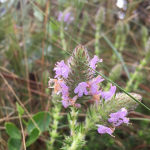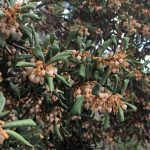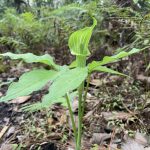Signs of “springtime” in central Florida…
If you’ve been a long-time reader of this blog, you already know that I love to highlight the unique changes of Florida’s seasons. “Springtime” in Florida is no exception.
(Click here for my earlier post about #FloridaFallColor, -or- here for one about spotted beebalm and the end of summer.)
NOTE – I put “springtime” in quotes because… well, technically, it’s still winter… BUT as the days grow longer, the signs of “spring” are all around – let’s take a look!
Winter, spring, summer & fall… February’s got them all!
The weather in January & February can be extremely unpredictable here – jumping from frosty to 85° practically overnight… But while the weather is a wild roller-coaster, central Florida boasts some surprisingly predictable seasonal sights. Here are just a few examples of my favorite sights to watch for each year…
Just in time for our native bees to emerge from their winter slumber, many plants in the heath / blueberry family (Ericaceae) put out a wonderful springtime show of fragrant, bell-shaped flowers.
(If you’ve ever lived “up north,” the delicate bells of Florida’s native blueberries and staggerbushes (Lyonia ferruginea and Lyonia fruticosa) might remind you of lily-of-the-valley. (While unrelated, it’s possibly an interesting example of convergent evolution?))
The whimsical pink flowers of shiny fetterbush (Lyonia lucida) are sometimes said to resemble fairy dresses… Meanwhile, in shady forests, Jack-in-the-pulpits are rising mysteriously from the rich leaf litter of hardwood hammocks…
…while redbuds, native plum trees (flatwoods & Chickasaw), and pink and yellow Tabebuia / Hadroanthus explode into bloom on nearly-leafless branches, sometimes carpeting the ground below with flowers…
Pines and red maples briefly join the action too, although you need to get up close to really appreciate the details…
If they haven’t been excessively pruned, Walter’s viburnums can put on a spectacular “springtime” display of tiny white flowers. From a distance, they almost look as though they’ve been covered in snow.
PRO-TIP: For shrubs like viburnums, azaleas, Simpson’s stoppers, and others that form flower buds on the tips of their new growth, be careful about the timing of your pruning! It can make an ENORMOUS difference in whether you get a stunning “springtime” show, vs. a ho-hum, patchy event…
Where spring meets fall…
Meanwhile, you may have noticed that oaks are performing their annual “fall+spring” (“fal-ing?”) trick, where they simultaneously drop their leaves, while also pushing out their new spring growth, practically overnight…
As the oaks drop their leaves, look UP! Springtime is the very best time to catch a brief clear glimpse of our native mistletoe, which will look like bright green, bushy tufts among the sparse branches. – TRIVIA FACT – Did you know that mistletoe is actually the larval host plant for the great purple hairstreak butterfly?

PRO-TIP – All those fallen oak leaves can be great additions to your compost, or can be used as free mulch! And fascinating recent research from UF suggests that oak leaves may even help citrus trees fight against HLB, also known as “citrus greening.” BONUS – By using those fallen leaves in your yard, you can help keep them out of your community’s storm drains and ponds. That’s a win-win!
Final thoughts…
Needless to say, I’ve really only scratched the surface of “springtime” seasonal sights. There are plenty of other plants I could include here… and we didn’t even begin to discuss the countless pollinators, songbirds, and other types of wildlife that are supported by these seasonal shows…
My goal was to highlight the fact that the signs of Florida’s seasons are all around you… if you know where to look. With a little creativity in your plant selection and landscape design, you can bring the sights (and fragrant blooms) of the seasons right into your own landscape and community.
PLANT SELECTION GUIDES –
Remember – the number one rule of Florida-Friendly Landscaping is “right plant, right place.” Here are some helpful guides to use when choosing plants that will work for your specific corner of FL.
- Florida Native Plant Society – Searchable plant selection guide for Florida native plants. This guide allows you to choose your county, select site characteristics, salt tolerance, etc. (NOTE: To avoid losing your search results, click the green “Back to List” button, rather than using the ‘back’ button on your browser.
- Waterwise Plant Selection Database – A user-friendly, searchable plant selection guide from the St. Johns River Water Management District (SJRWMD) – This guide includes both native and non-native “Florida-Friendly” options. The guide allows you to select plant type (groundcover, flower, ferns, trees, vines, etc.), soil conditions, plant height, growth characteristics, flower color, etc. Includes photos for many plants.
- Florida Friendly Landscaping Plant Selection Guide – An updated searchable plant list that includes both native and non-native “Florida-Friendly” options. You can browse all the plants, or do a custom search by plant type, site conditions, native status, and more!
- NOTE: If you live within the Southwest Florida Water management District, you can also request a paper copy of the UF/IFAS publication – Florida-Friendly LandscapingTM Guide to Plant Selection & Landscape Design. Click this link to visit the free publications section of the Southwest Florida Water Management’s page, WaterMatters.org. Outside of the SWFWMD region, check with your local UF/IFAS Extension office – http://sfyl.ifas.ufl.edu/find-your-local-office/
- Other UF/IFAS online materials: There is an enormous collection of information available online from UF/IFAS. I always tell people, “If it grows in Florida, UF/IFAS has info for you.” Simply go to your favorite search engine, type (-the name of the plant/animal-) and ‘IFAS’ and you’ll have a really good starting point.
About the Author: As the Florida Friendly Landscaping (FFL) Program Coordinator in Pasco County, I work with the residents, homebuilders, and businesses of Pasco to help create vibrant landscapes that WON’T require a lot of water, fertilizer, and pesticides to look good. Through an innovative collaboration with Pasco County Utilities, the Pasco County FFL Program also provides on-site troubleshooting assistance to individuals and communities identified as high water users. My motto is – “Less guesswork, better landscapes.” I can be reached at fgaldo@ufl.edu
Thirsty for more FFL knowledge? Don’t forget to follow us on Facebook & Twitter!
Have a question, or an idea for a future post? Let me know at fgaldo@ufl.edu or leave a comment below.
by Frank Galdo
UF/IFAS Extension Is An Equal Opportunity Institution.
 0
0














